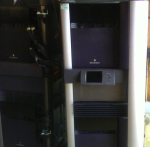Hi,
we are building a small disk array in our studio and I would like to ask what would be the best setup to use.
We did some benchmarks, but we have all but the time to tweak & test all filesystems/parameters.
So, my question would be if anyone here has experience with similar setup. (9 x 1.5TB hdd)
Primary task for the array is shared storage for video files (20-30gb each).
So far, we have been using 7 x 1.5TB and ext3, which has become quite laggy over time (creating directory takes more than 20 seconds if the utilization of array is above 80%). We used raw raid5+ext3, no lvm.
Do you think the setup mentioned in subject is ok, and if so, what parameters to use for xfs?
thanks for any suggestions
we are building a small disk array in our studio and I would like to ask what would be the best setup to use.
We did some benchmarks, but we have all but the time to tweak & test all filesystems/parameters.
So, my question would be if anyone here has experience with similar setup. (9 x 1.5TB hdd)
Primary task for the array is shared storage for video files (20-30gb each).
So far, we have been using 7 x 1.5TB and ext3, which has become quite laggy over time (creating directory takes more than 20 seconds if the utilization of array is above 80%). We used raw raid5+ext3, no lvm.
Do you think the setup mentioned in subject is ok, and if so, what parameters to use for xfs?
thanks for any suggestions
_________________

 This post was typed using dvorak keyboard layout -
http://www.dvzine.org
This post was typed using dvorak keyboard layout -
http://www.dvzine.org

















 (2x)
(2x)















 (single-CM)
(single-CM)